We can smell the woodsmoke first, and then the carnitas. Fernando carries a cake, and Arturo carries a cooler. People are drinking beer in the shade of a palapa while shrieking children run around the dirt yard.
We are here in Cabo Corrientes, Jalisco, at the taberna of Don Adrián Rodríguez, for the birthday party of his son Paulo. The rustic distillery is in the heart of raicilla country. The taberna is just above the palapa where the party is taking place. Both are open air structures with thatched roofs.
I’m mildly surprised the family is making carnitas instead of something more archetypically regional, like birria. But other than that, the scene is everything you might expect from a rural party in coastal Jalisco. The hosts are preparing ceviche, a barrel is full of ice and beer, the kids keep asking when we’re going to do the piñata, a lot of people are wearing cowboy hats, and a boombox in blaring ranchera music. A group of older men and women are gathered around a giant pot that’s bubbling over a fire. But the carnitas aren’t the only thing that’s cooking—or about to cook.
Don Adrián personally serves us miniature Coronas and plastic cups of raicilla, the region’s traditional mezcal. Once we’re properly supplied, he summons us up to the taberna, where a crew of men are tossing split agave hearts into the stone-lined pit. They make it look easy, like the piñas weigh a few pounds, but I know they are so heavy I can barely lift one over my head.
In the bottom of the pit oven, embers smolder beneath hot rocks covered in wet agave fiber. When the oven is full, the men cover the agave with mats and begin sealing the pit with palm fronds and dirt. A tall stick is lodged in the middle of the mound, and the crowning moment is when a boy climbs up and pulls it out, creating a channel down to the stones. He pours a bucket of water into the hole and clouds of steam billow out. Everyone cheers. The piñas will roast for three days.
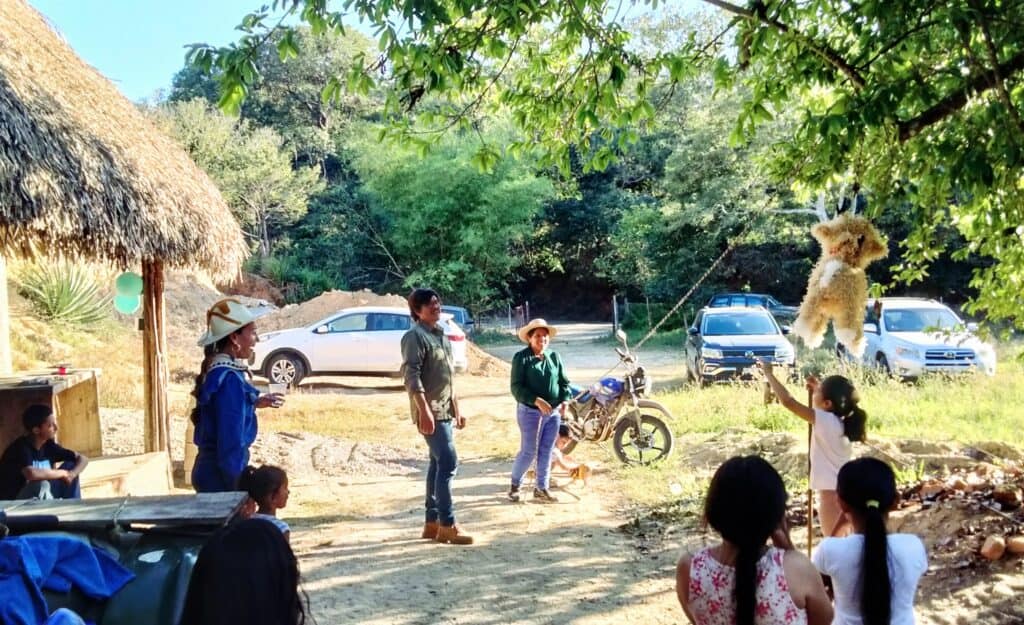
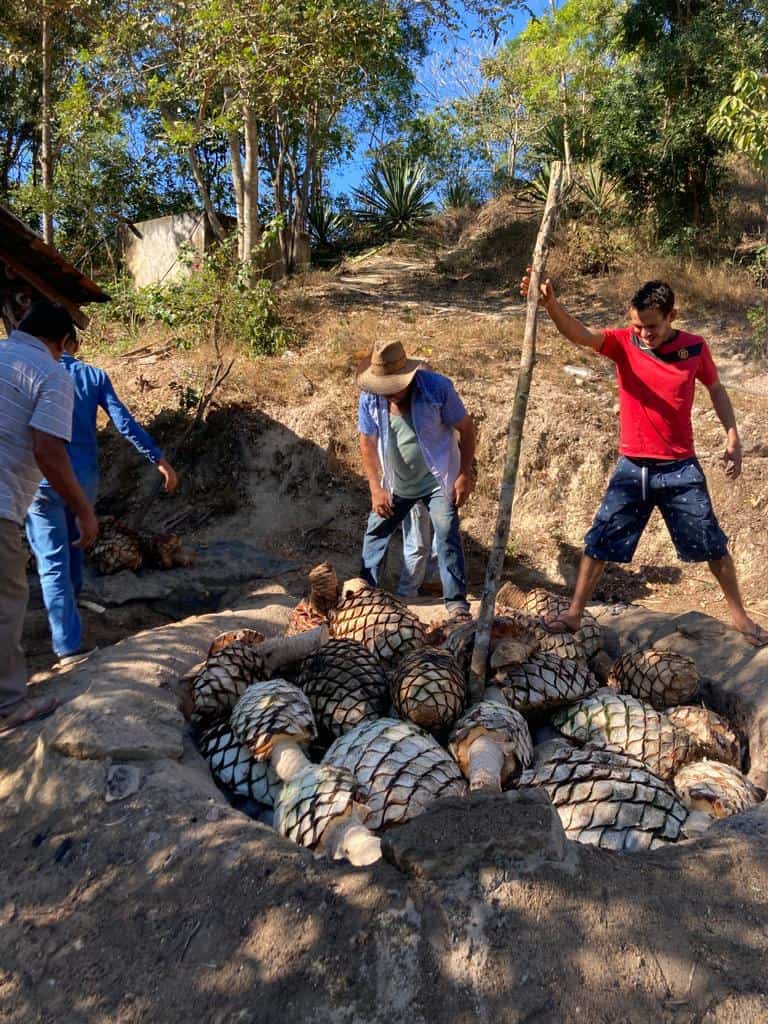
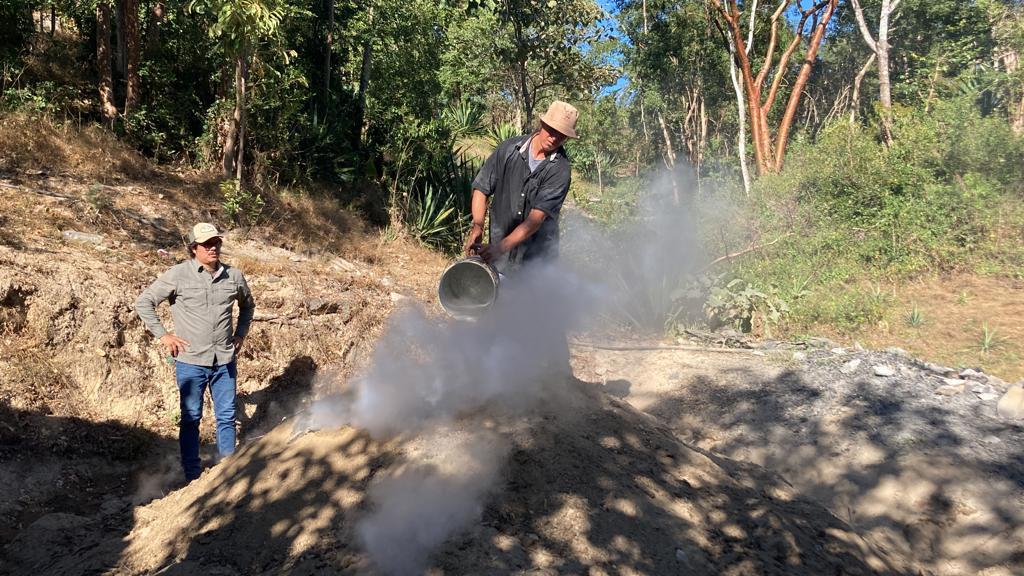
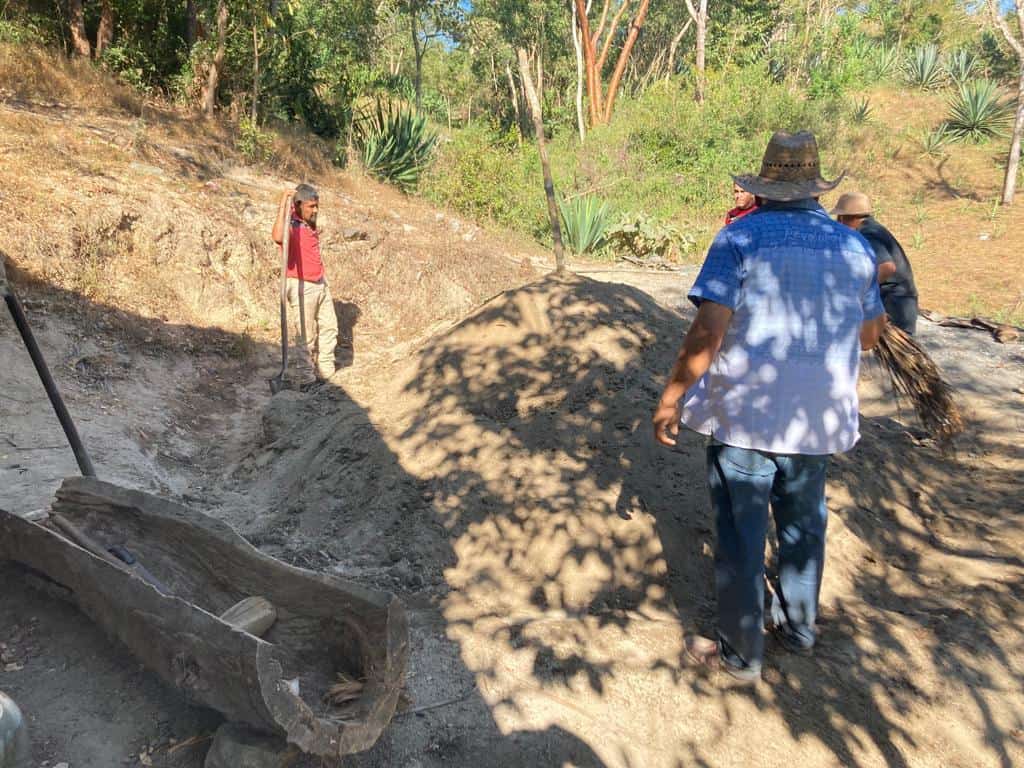
A nearby canoa hints at what’s to come. After Don Adrián’s crew dig the roasted agave out of the oven, they’ll use a heavy club to beat it to shreds in this hollowed-out tree trunk, which resembles a canoe.
Don Adrián makes some of the best raicilla in the world, in the traditional coastal style. The liquor is double-distilled in wood-heated Filipino-style stills made out of tree trunks. He shows us the agave fermenting for the next batch. A heady brew is percolating in the food-grade plastic tinacos of the type you see on roofs all over Mexico. He explains how he places volcanic rocks on top of the agave fiber to prevent it all from floating to the top of the tank.
“Taste it,” he says with evident satisfaction.
I dip my finger into the tank. The ferment is indeed tasty—like a rich and savory agave ale.
Coastal raicilla and the origins of mezcal
Coastal raicilla has been made this way, more or less, for centuries. The wooden stills were introduced by Filipinos who sailed the Spanish trade route from Manila to the coast of the land we now call Mexico. They had a penchant for coconut brandy, which they made with portable wooden stills[i]. Some settled on the coast and shared this technology with the locals. It was a no-brainer to begin distilling agave—the plant was already a mainstay of life; roasted agave and pulque were crucial sources of sustenance, and people used the spiky leaves to make everything from roof tiles to needles.
The slopes about Don Adrián’s taberna are planted with many types of agave—his fields are among the most diverse in the region. The late afternoon light illuminates the red thorns of pencas, shaded by the spreading branches of a primavera tree, bright with yellow blossoms. The land here is jungle, a distinct contrast to Jalisco’s other raicilla “de la sierra,” which is produced to the east in the mountains, where agave grows amongst the pines.
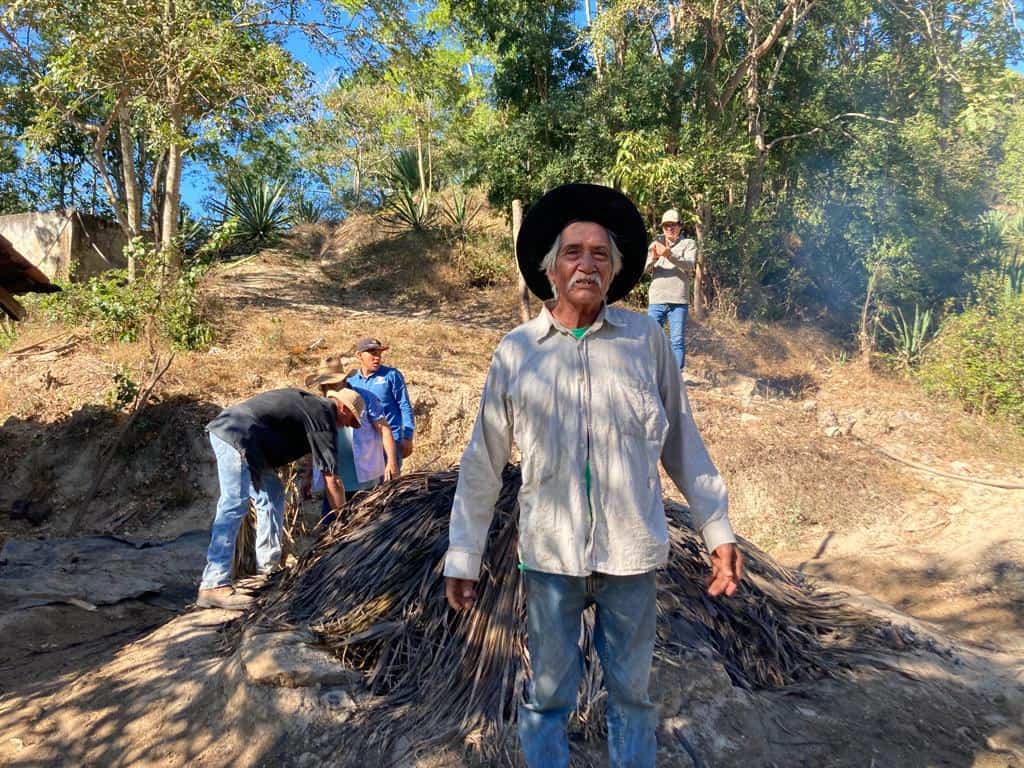
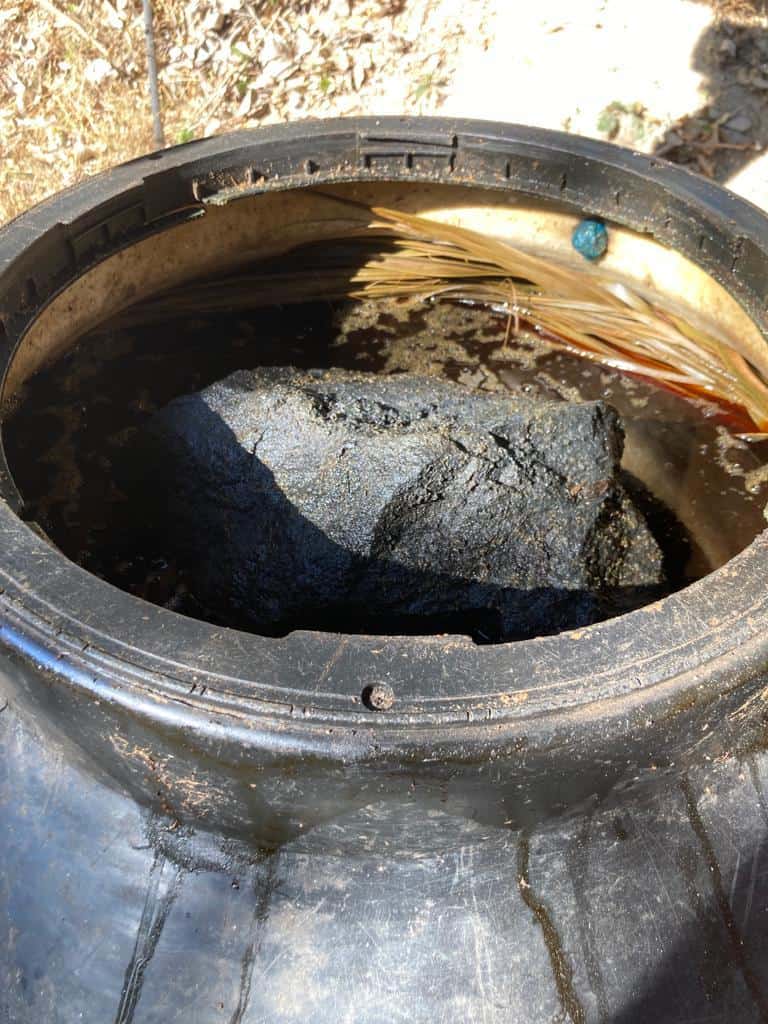
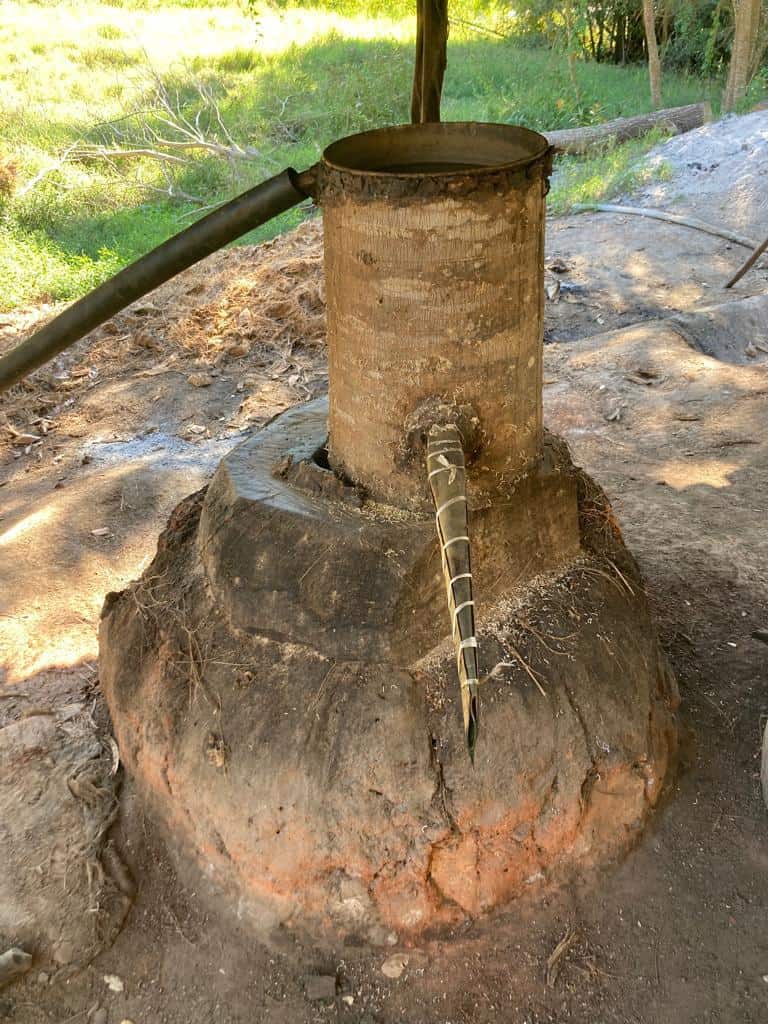
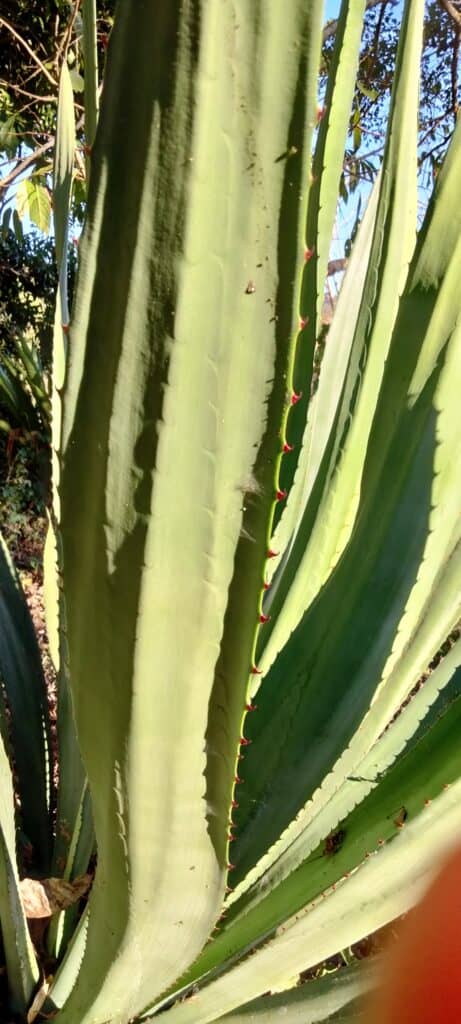
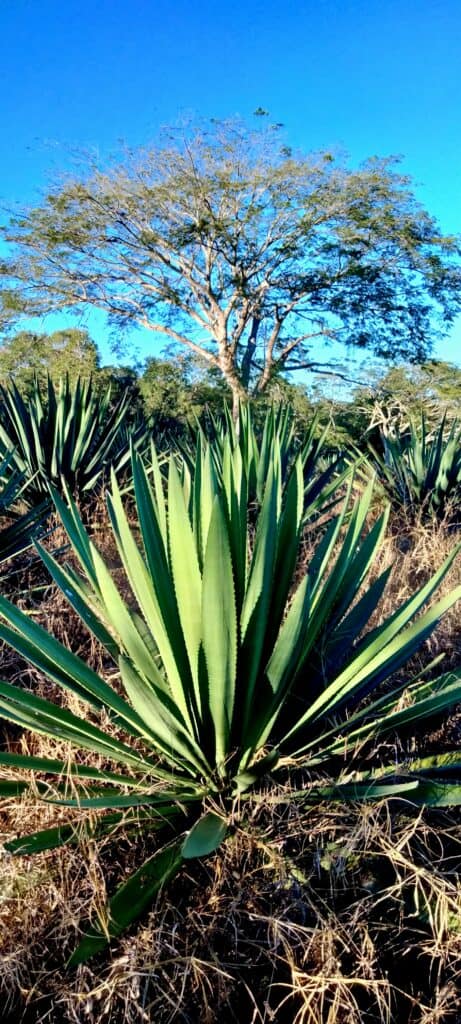
What is raicilla de la sierra?
A year ago, we attended a raicilla festival in the little mountain town of San Gregorio, a few hours on a very bad road from Mascota, the epicenter for “raicilla de la sierra.”
We parked in a field next to some mud-splattered pick-ups and walked up a dirt road into town. San Gregorio is so small it only has one store, and the town plaza and church are miniature. In contrast, the festival was held in a spacious structure, rather like an open-air basketball court, that had the distinct whiff of a government project.
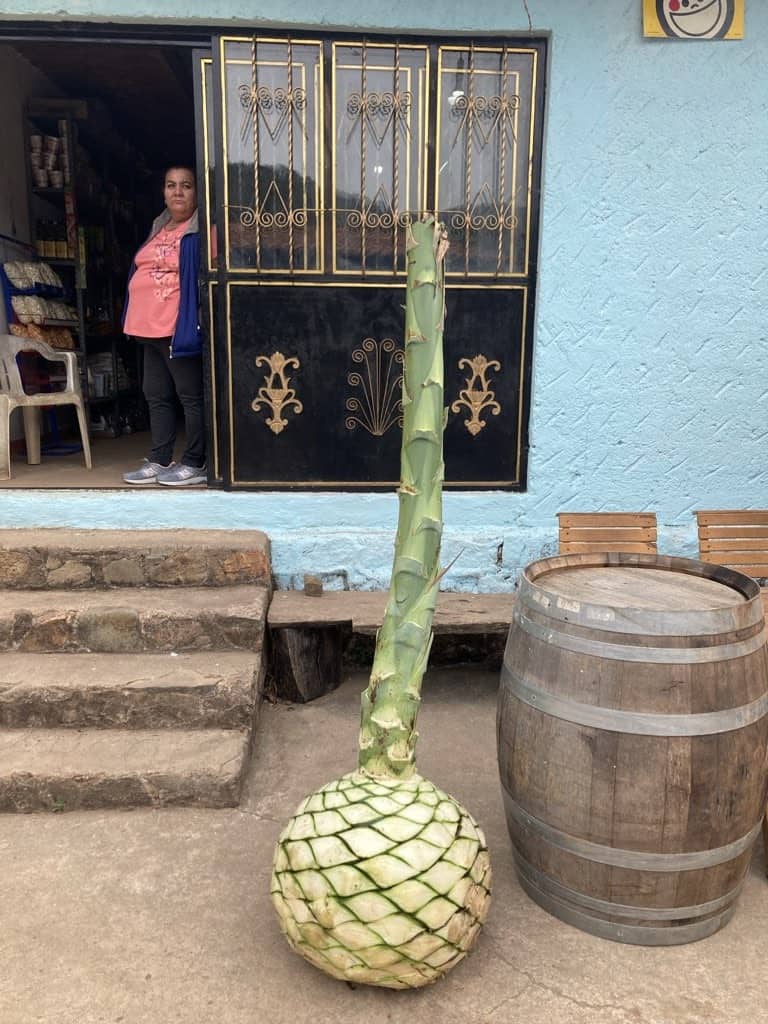
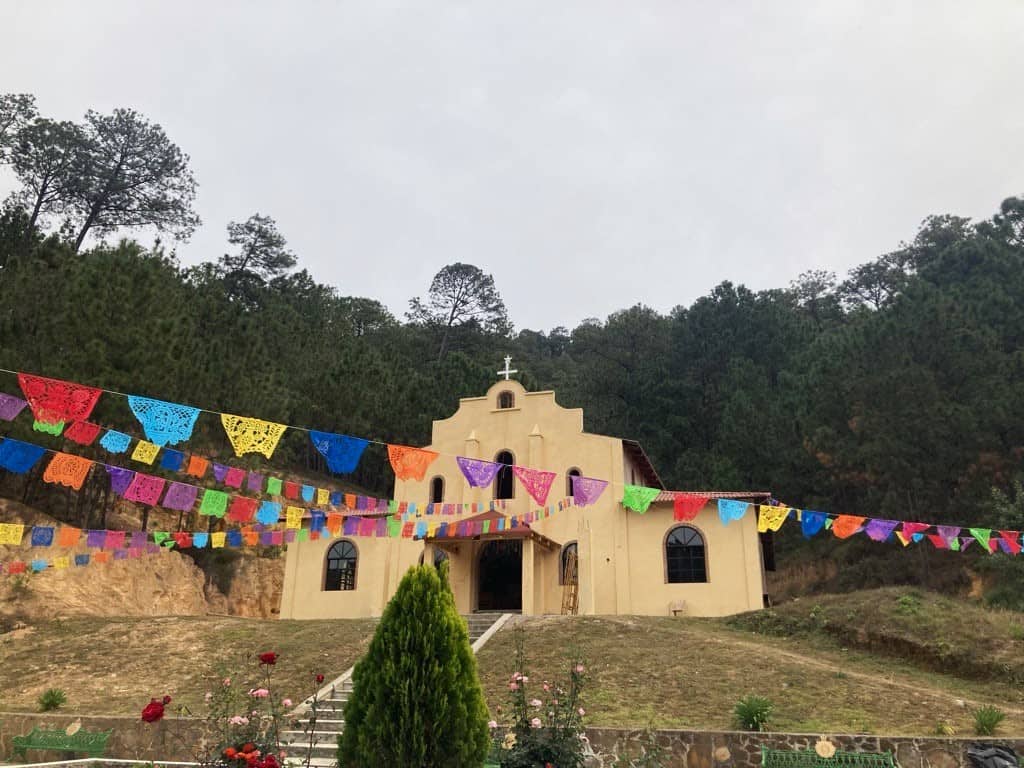
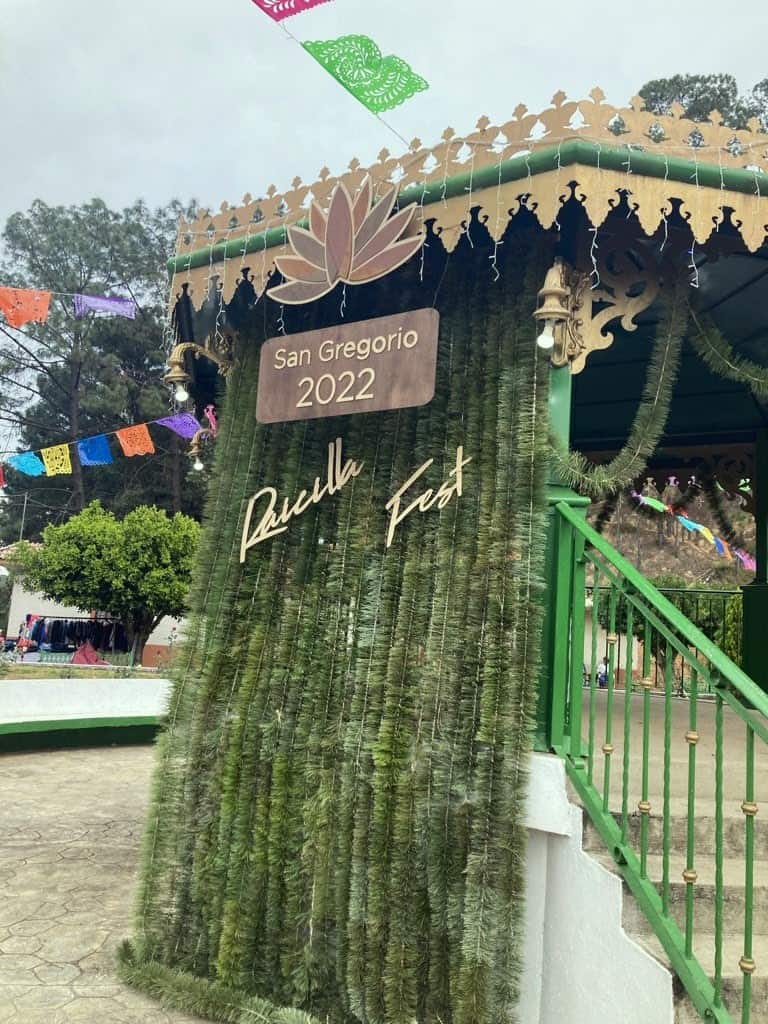
Indeed the festival is sponsored by the state government to encourage raicilla tourism and an appreciation for raicilla de la sierra. That said, the vibe was very ranchero. The distillers and their families were stepping out in their best western wear and nearly everyone seemed to be related in some way or another; the majority of the attendees had the surname Topete or Arce.
Proud producers arranged their bottles in booths and proffered shots of raicilla. Of the thirteen brands on display, twelve were from the San Gregorio area. This blew my mind. When I visited Mascota six years ago, most people were still selling in unmarked bottles and only a few actual brands were available at the local raicilla bar.
Where to taste raicilla in Mascota
Although I’m sad to report that rustic, candlelit establishment no longer exists, it has been replaced by La Taberna, a tasting room run by the Consejo Mexicano Promotor de Raicilla, or raicilla promotional council. Visitors can sample from a floor-to-ceiling wall of branded bottles. The price for a small shot is surprisingly inexpensive, allowing for a truly educational experience. We tried eight expressions and walked away feeling giddy but not drunk or broke. The bar also sells bottles.
The Consejo touts raicilla as a “sensorial and cultural treasure of Mexico.” The organization has done much to put raicilla on the map, including helping to establish a denomination of origin for raicilla (DOR) in 2019. The DOR covers 16 municipalities in the state of Jalisco: Atengo, Chiquilistlán, Juchitlán, Tecolotlán, Tenamaxtlán, Puerto Vallarta, Cabo Corrientes, Tomatlán, Atenguillo, Ayutla, Cuautla, Guachinango, Mascota, Mixtlán, San Sebastián del Oeste, and Talpa de Allende, as well as Bahía de Banderas, which is in the neighboring state of Nayarit.
Since the establishment of the DOR, anyone making a mezcal outside of these regions can’t legally call their product raicilla. In order to go legit, raicilla distillers will eventually need to be able to prove that their production processes meet certain standards. These standards, or “norms” have been written, but have not yet been approved by the federal government. Like the DOR itself, the norms have been subject to controversy among certain producers and academics.
According to the government statement on the new denomination of origin, “producers of raicilla will benefit directly, since this protection will allow people to recognize the quality, tradition, and originality of this drink, which will facilitate their access to national and international markets, as well as receive adequate remuneration, for the direct benefit of their communities and their families.”
Whether a DO will help small producers is a subject of debate, but it’s clear that the Consejo has fomented interest. Ten years ago, raicilla was dismissed as moonshine and largely unknown outside of Jalisco, but now the spirit is appearing on backbars around the world—though the selection is limited.
What is the difference between raicilla and mezcal?
An increasing number of agave aficionados are learning to appreciate that raicilla is just another type of mezcal–even if it can’t legally be labeled as such because it falls outside the giant and seemingly arbitrary DOM (denomination of origin for mezcal). This growing interest has precipitated an uptake in production, most evident in the mountains, where many producers are first generation—a contrast to the coast, where taberneros are typically heirs to a long family tradition.
It remains to be seen if raicilla is actually the next big thing. Many of the brands we saw at the festival in San Gregorio may never make it to the US, and more than a few will likely fold when the norms are established and tabernas become subject to inspection and potentially costly requirements. But people seemed celebratory and hopeful.
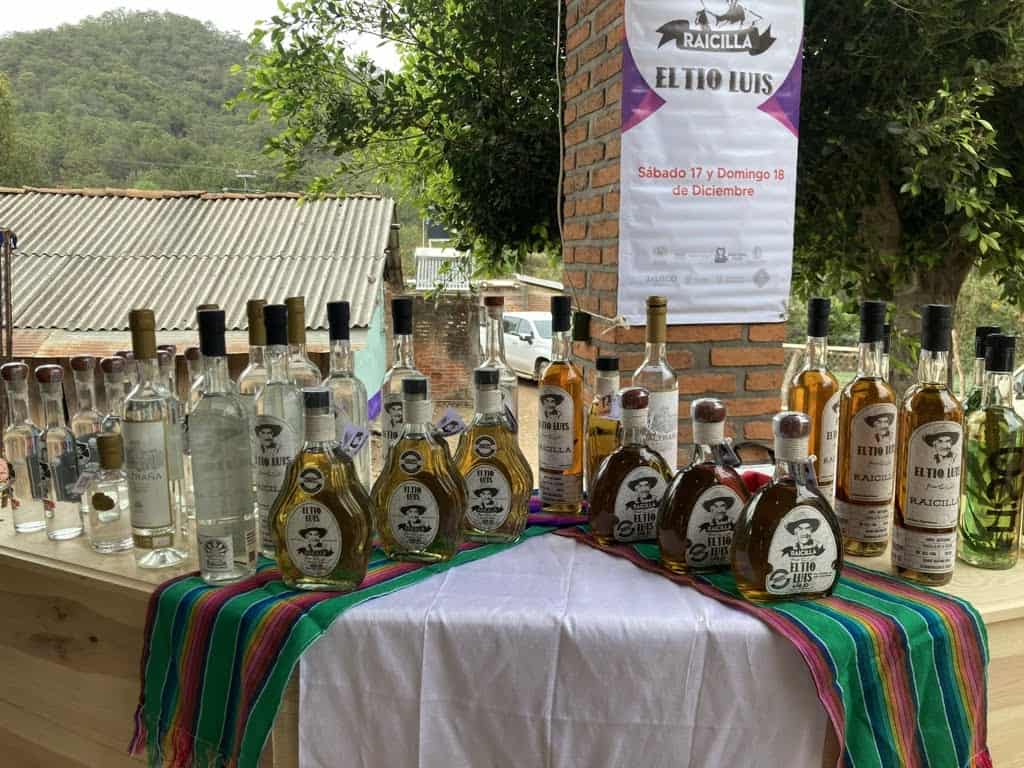
We met two brothers from Iowa with local roots who invited us to a nearby taberna, where their cousin works with maestro Pedro Topete Peña to make their brand, Tres Siglos. The scene was convivial. Their dad, who was also visiting from Iowa, plied us with cups of (very good) raicilla from a glass garrafón.
The family construction business in Iowa helped fund the handsome new taberna with a cement floor and tin roof supported by massive, gnarled tree trunks. Like Don Adrian’s taberna on the coast, the structure is open air, but there were several differences in the methods of production, most notably an above-ground stone oven where a fire burned merrily. A sleepy dog guarded a pile of split piñas.
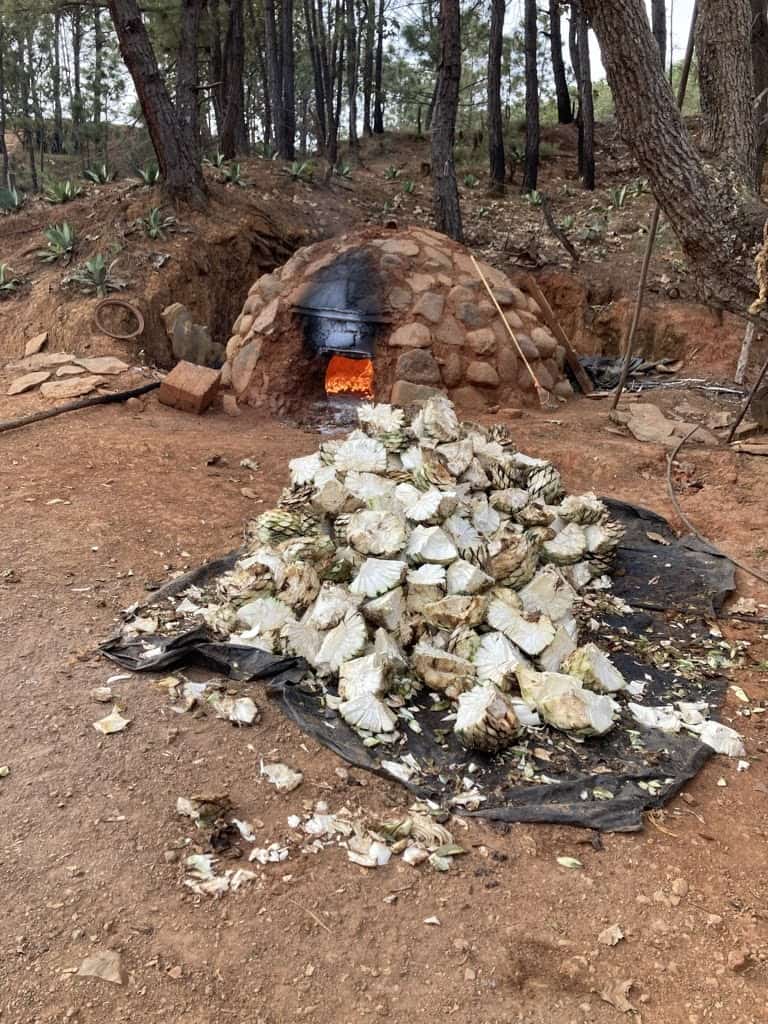
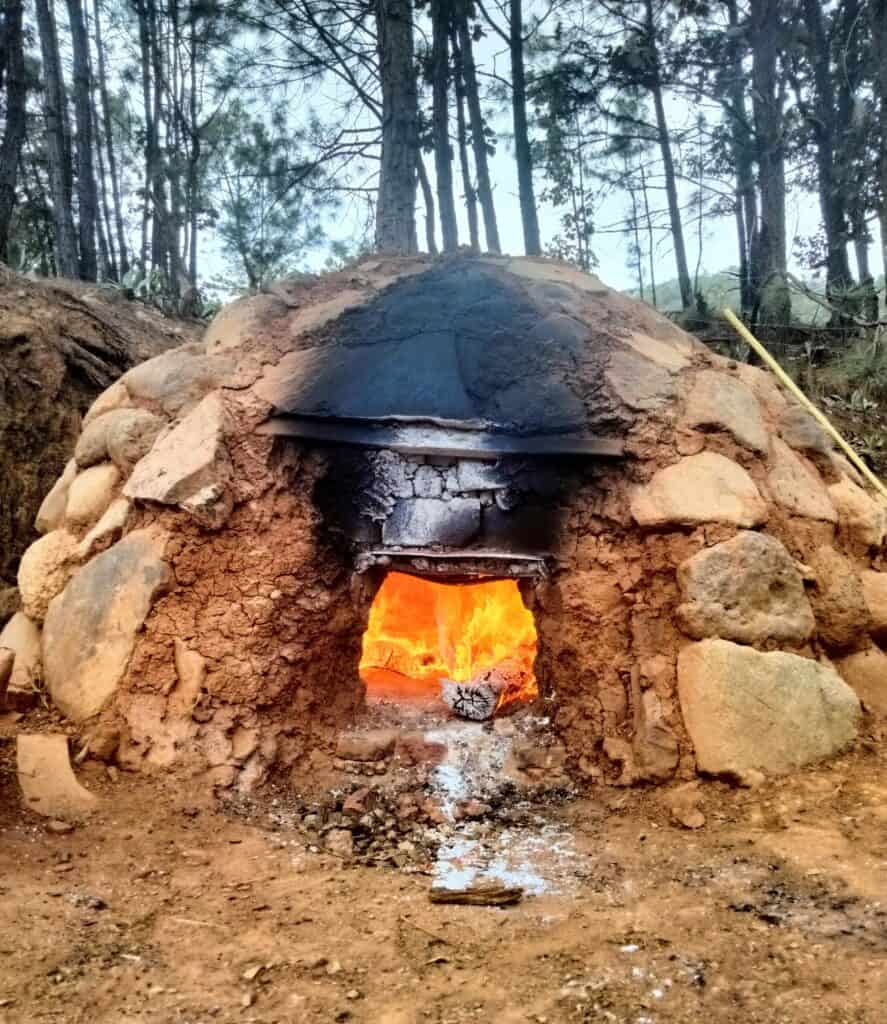
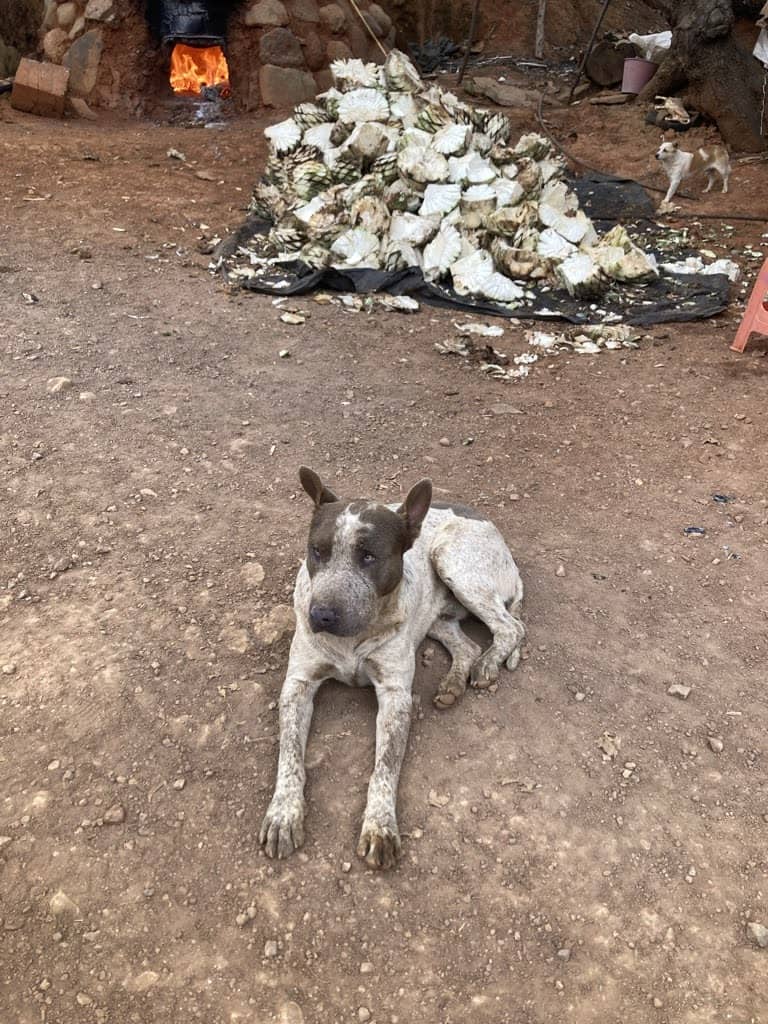
The igloo-shaped oven is a defining feature of the mountain tabernas, which typically house alembic stills. The two types of raicilla vary significantly in production methods and flavor. Mountain raicilla is primarily made with Agave maximiliana, commonly referred to as lechugilla, while coastal raicilla is typically derived from varieties of A. angustifolia and A. rhodacantha. While all coastal raicilla is double-distilled, some sierra raicilla is single distilled. These distinctions and the dramatic difference in terroir result in distinct spirits, to the point that there’s a solid argument that two DOs for raicilla would make a lot more sense than one.
Bringing raicilla out of the shadows
But back to the party. Paulo’s birthday at Don Adrián’s taberna is a mixed crowd: Local family and friends share the palapa with guests from the city, including Arturo Dávila and Larissa Carillo Solís, brand owners who have family roots in Cabo Corrientes.
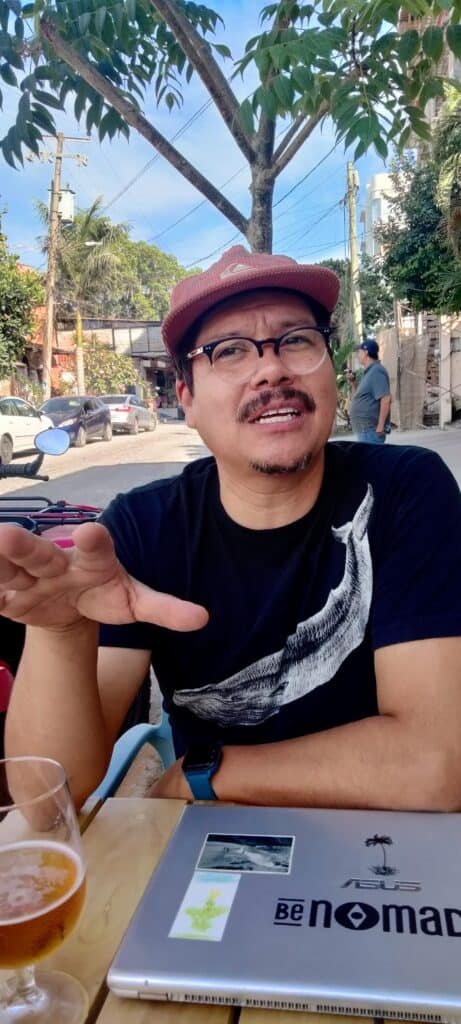

Both Arturo and Larissa grew up on the margin of the Puerto Vallarta neighborhood that is currently known as the Zona Romantica. Now a hot spot of gay tourism, the area was once farmland settled by families from Cabo Corrientes. Although Arturo and Larissa are educated urbanites, they retain strong family and sentimental ties to their ancestral rural homeland and hope that their brands will bring money and accolades to the impoverished coastal region. Arturo is also working with various partners to highlight coastal raicilla via a tour business and bar in Puerto Vallarta.
Larissa, who spent 22 years working as an air traffic controller, was inspired to start her brand to honor her father, who died in 2019. He left Cabo Corrientes on a scholarship to become a high school science teacher in Vallarta, but remained deeply involved in his home community and worked with local expats to start a scholarship program for other rural kids. The name of Larissa’s brand Eterno Embrujo, is a nod to her father who was affectionately nicknamed “El Brujo” (the wizard).
“My first memories of raicilla are from when I was very little,” Larissa recalls. “When we came home from the country, we brought liters of raicilla with us. We always had raicilla in the house. When people would visit, my father would offer them a nightcap of raicilla. It wasn’t something to get drunk on, it was something special, a treat.”
Larissa’s raicilla is produced at the taberna of the legendary Don Hildegardo “Japo” Joya. Don Japo, who is 91, directs operations, overseeing his sons, Pedro and Saúl. Larissa’s grandfather was a dear friend of Japo’s. They grew up together, fishing and working in the woods. Larissa considered other producers, but says, “Because my work is sentimental, it seemed right to work with Japo.”
Don Japo is a longtime producer for Mezonte, but Larissa says that Mezonte project architect Pedro Jiménez has been supportive of her collaboration with the Joyas.
“What I’m looking for, and what I think Pedro from Mezonte wants too, is for Japo’s family to have more opportunities and for there to be opportunity for growth in the community as a whole.”
Arturo’s brand, Atarraya, which he co-owns with partners, showcases the work of seven coastal producers. Each expression in their line is the work of a specific producer, including Don Adrian and his two sons, Paolo and Joel. Arturo’s original idea was to work with seven different families but he says that highlighting the work of three distillers from the same family is a good way to demonstrate the artistry of the producers.
“For me they are creators; in the end each creator looks for their own style,” he says. “Like any artist, they look for their own signature, their stamp. And in the families—when they work, they support each other physically. But there’s always a moment when the others step back. They don’t interfere with each other’s processes. In the moments of design, they don’t opine. And it’s very cool because they work in the same place, with the same agave, with the same water, with the same everything, and yet they produce something different.”
The growing interest in raicilla has a dark side—the potential for environmental and cultural exploitation, and the very real possibility that increased attention and attendant regulation will actually harm small taberneros. But at the same time, there’s an excitement to it, the joy of seeing producers, who have labored most of their lives in obscurity, elevated at last for their art.
Don Adrian’s personal brand, Tres Hombres, is a nod to familial collaboration. The “three men” are him and his sons. The sons who continue their father’s art are certainly worth celebrating–as is an urban generation coming home to help in their own way.
Like their Iowan counterparts in San Gregorio, Larissa and Arturo see the value of their community traditions and have returned to invest–not only money, but time and kinship. This sense of raicilla as a conduit to family, to community, to cultural pride, is something that comes up every time I talk to a producer or brand owner.
“My favorite part of being in the raicilla business is everything that I’ve learned,” Larissa says. “I still have much to learn, but I’ve gotten to know a lot of incredible people and developed such a strong connection with my community. I see my cousins from Chimo much more now. We have a lot more to connect about now. Before I was wrapped up in my work at the airport and they in their fishing, but now we have more to talk about. And I love this connection that I’d once lost.”
As we share a drink with Don Adrián and the sun casts shadows across the gold fields, all of the good things are evident—family, community, culture, connection, carnitas, and, last but not least, the drink itself—bright and acidic, with a hint of brine, and a vibrant note of sweet jungle fruit. Don Adrián gazes out at his family and fields, takes another sip of raicilla, and looks satisfied with his work.
[i] [i] Machuca, Paulina. 2018. El Vino de Cocos en la Nueva España.


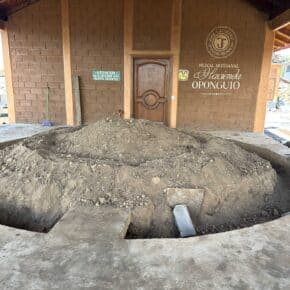
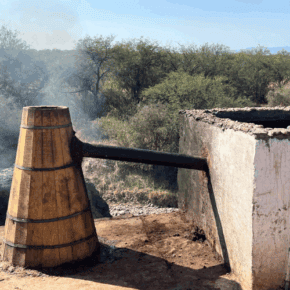








In-depth, authentic report! Love it!